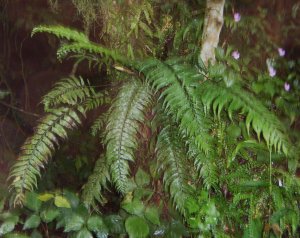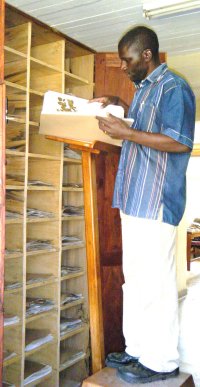 |
QUICK SEARCH
MO PROJECTS:
Africa
Asia/Pacific
Mesoamerica
North America
South America
General Taxonomy
Photo Essays
Training in Latin
America
MO RESEARCH:
Wm. L. Brown Center
Bryology
GIS
Graduate Studies
Research Experiences
for Undergraduates
Imaging Lab
Library
MBG Press
Publications
Climate Change
Catalog Fossil Plants
MO DATABASES:
W³MOST
Image Index
Rare Books
Angiosperm
Phylogeny
Res Botanica
All Databases
INFORMATION:
What's New?
People at MO
Visitor's Guide
Herbarium
Jobs & Fellowships
Symposium
Research Links
Site Map
Search
Canisius Kayombo,
|

|
I was born in 1967, in the southern highlands of Tanzania, Ludewa District, Iringa region, a few kilometers north of the Livingstone Mountain Ranges. From the age of four, I started getting involved in cattle grazing with my elder brothers. At the age of six to seven years, I became a full cattle grazing boy. In 1975, I was taken to Lupande Primary School in Lupande Village in the southern highlands of Tanzania. In 1981, I sat for the primary school education final examination; but unfortunately, the whole class failed. I cried for five months because of the failure. My parents did not have a primary education, except as adults which just helped them to sign documents when receiving payments and any necessary official documents. They could neither read nor write anything apart from just their names.
My father became sick in 1979, and in 1980 he moved to another district within Iringa Region more than 250 km away. While he was gone, I sat for the final school examination.
My mother, who was alone at that time, asked me why my teachers did not appoint me to a secondary education! I had nothing critical to reply to her because selection depended on what I did during the final examination. She was unhappy, and said: "I wonder why you are not going to school...I always see other people’s children going to secondary school, and then back during school holidays! Why not you?" Because of this question, I requested that she provide me with some money so that I could go to the district town and wait for examination day. Unfortunately, she had only sixty Tanzanian shillings which were only enough for transport fare for a distance of more than 100 km. I was given the sixty shillings, but I decided to walk the distance hoping that the sixty shillings could solve other problems at the destination.
On the way, I met my colleague from the nearby village, and we walked together to Ludewa township. We felt very tired and hungry and bought fresh roasted maize eating it as we continued our very quick walk. It took us 24 hectic hours to walk to Ludewa township. It was 2:00 AM the next day when we arrived, and my friend left me for his destination. I walked around the streets and found a small mud constructed hut that was roofed with grasses. I entered and slept on a wooden bed until 8:00 AM. Upon waking up, I was very afraid, because I saw clothes belonging to someone living in the hut who probably would turn up.
After that, I went around seeking work to do in return for payment. Suddenly, I met an old man who offered me employment to work in his hotel. I worked for two weeks, then requested that he assign me to a different duty. I had been responsible for collecting money for the hotel, and someone else was taking the money from the cash box. My employer understood and took me to his farm which was about 15 km away. He wanted me to cultivate it using a hand hoe. I was happy to do that having cultivated at home. The area was covered by Miombo woodland which had never been disturbed for more than sixty years. The soil was very compacted, and the whole area was full of biting ants. Whenever I was working, they would bite me bitterly. I tried to find an area where there were no ants, but they were ubiquitous even on the grasses and trees.
Due to that situation, I decided to leave the hoe there and went back to the township where I met my former primary school mate. Together we found a job with a Mr. Abdallah who was a driver working with the Ministry of Livestock. We worked and stayed at his home without any payment to him.
The first day, my friend and I weeded three acres of maize. We started weeding very hard. At the same time, I thought of seeking another place to work for school tuition. Fortunately at Ludewa Primary School, one of the teachers volunteered to teach me. In the evening, she gave me 40 questions to study for the entrance examination. The questions were for language, geography, science, and mathematics. I studied hard, and the teacher assured me that I was definitely going to pass my coming examinations for the private secondary school.
In December 1982, I sat for the examination to join Madunda Secondary School, which was located in the Livingstone Mountains north of Lake Nyasa [Lake Malawi]. Soon after Christmas, the results were out, and I was among the selected candidates joining Madunda Private Secondary School. Being a very young boy from a poor self employed small scale farming family, I went back to my mother and told her the story about school. She was very happy with the news; however, there was no money for me to go to school. On her own, she decided to sell the only bull from the family's ten cows. I do not remember how much money that was, but she gave all of it for fees and other necessary expenditures for only one semester. The school was about 20 km from my home village, and there was no transport at all. I had to walk to school and back home during school holidays.
I spent only one semester at Madunda Secondary School which did not meet my expectations. I looked for another opportunity at the Highlands Secondary School in the Iringa municipality. It was about 400 km away, but it was difficult to get a letter of transfer. When I told my mother that I wanted to leave the school for another one, and the headmaster heard this, he was very angry and punished me. He said: "You went home without permission from me...You have bothered your mother... You have to make 200 bricks as punishment, and then I will give you a letter of transfer to where you want to go". But then, I found out that there was no chance for me at the new school! Instead of entering the second year of secondary education, I had to sit for an entrance examination again in order to start the first year of school over!
By the end of 1983, I sat for the examination, passed it and started my first year of secondary school over again. In the beginning of 1984, my lovely mother passed away. It took me one year of crying for my dead mother. Life became very difficult for income, I had to rely on casual labor like weeding maize and beans. Because kerosene is a major source of energy for light when studying and charcoal is needed for cooking food; whenever I ran short of charcoal, I went out cutting tree logs and making charcoal. When I got to form three, I managed to buy and sell commodities earning at least some sort of income.
During 1985 the time in form two (my second year), I heard about Dr. Jon Lovett, a botanist, working with the Missouri Botanical Garden in Tanzania. I sent a letter to him through his garden man. He was happy to receive my request and asked me to visit him during the school holiday which I did. He promised me an employment opportunity soon after completing my secondary education.

|
However, during my third year of secondary education, I became involved in selling commodities, and I hoped that it could be my best source of income throughout my life. I continued with this business for one year after my secondary education. But later on, this work became very difficult without noticeable profit. In 1988, I decided to go to Igowole Village, my new home village.
In October 1987, Dr. Jon Lovett sent a letter for employment to my father. I visited his office in Mufindi early in October 1988, but he was in Dar-Es-Salaam. His wife asked me to come back when Jon Lovett returned. Roy Gereau, also a botanist from the Missouri Botanical Garden, was there too. He wanted me to start working that very day with pay. However, further discussion took place, whereby I was asked to wait until Dr. Jon Lovett was back. I consulted him in November and started working with plants.
I did not know much about plants. I could see Dr. Jon Lovett and Roy Gereau writing strange words which whenever I tried to go through the normal dictionary, I could not find them at all. Later on, I came to know that they were scientific names, and thus I needed specific botanical books to understand what had been written. I was assigned to be the Botanical Field Supervisor. Later on, I was taught how to describe habitats, plant specimens, collect them, and dry them using various methods. Also, I was taught how to identify them using botanical books with identification keys.
Since then, I have been working with different people from Tanzania and other countries conducting botanical inventories in many localities in Tanzania. In 1991, I went for advanced secondary education, while still working for Missouri Botanical Garden in Tanzania.
| Home | Work Experience | Education | Publications | Biography | Contact | Recommendations |
© 1995-2025 Missouri Botanical Garden, All Rights Reserved
4344 Shaw Blvd.
St. Louis, MO 63110
(314) 577-5100
Technical Support